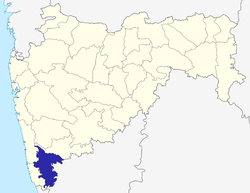Siddhagiri Gramjivan Museum (Kaneri Math)
Siddhagiri Gramjivan Museum (Kaneri Math) at Kaneri, Kolhapur district, Maharashtra, is a sculpture museum. The full name is Siddhagiri Gramjivan (Village life) Museum. It is situated at Shri Kshetra Siddhagiri Math, a campus built around the Moola-Kaadsiddheswar Shiva temple.[1]
 | |
| Location | Kolhapur, Maharashtra, India |
|---|---|
Museum description
This museum showcases different aspects of Gramjivan (village life). Gram means village and jivan means life in the Marathi language. This initiative was the dream of Mahatma Gandhi, and was created through the vision and efforts of Siddhagiri Gurukul Foundation. The history of self-sufficient village life in Maharshtra, before the invasion of the Mughals, is depicted in the form of cement sculptures. Each sculpture is lifelike and represents activities performed in daily village life. There were 12 Balutedars (essentially artisan castes), and 18 Alutedars who provided equipment to carry out domestic and professional tasks.
The museum is spread over 7 acres (28,000 m2), and the surrounding countryside is beautiful, with lush greenery. Every aspect of village life has been depicted in almost 80 scenes that showcase more than 300 statues.
Village scenes
The scenes of village life include:
- Village priest’s abode. The first scene is the house of a highly educated village priest. He performs his duties, rites and rituals like weddings and thread ceremonies, and is tasked to find auspicious days and times for any major activity such as house-building and house-warming activities, digging wells, sowing seeds, piercing nose or ears. He earns his livelihood from Dakshina (donations) he receives. He consults the Panchaang (almanac) for finding auspicious dates.
- Goldsmith at work
- Ironsmith shoeing a bullock
- Barber shop
- Village well - villagers fetching water from the public well.
- Nursing an elder family member
- Grocer’s shop - a woman visiting the grocery shop with her son. The shop-keeper is weighing items in an old weighing machine. Items like jaggery, sugar, chillies, salt, wheat, and rice are stocked. The son is asking his mother to buy kites for him.
- Farmer’s wada (house)
- House of Vaidya
- Grandma stitching a godhadi (quilt)
- Farmers ploughing his farm using a bullock-drawn plow
- Shepherd boy with his herd of sheep
- Villagers performing Bhajan and Kirtan (singing Hindu devotional songs)
Shiva temple
The museum has an old Shiva temple on the grounds.[2] It is related to the Inchegeri Sampradaya, to which Nisargadatta Maharaj belongs. It is believed that a Shivling was installed by a Lingayat Priest on a beautiful hill in the 14th century. About 500 years ago, a Lingayat Priest, Shree Kadsiddheshwar Maharaj, developed and renovated it, and hence the place is now known by his name. The temple includes a 125 feet (38 m)-deep well, a 42 feet (13 m) Shiva idol, and a large Nandi bull.[3][4]
References
- Siddhagiri Gramjivan MuseumArchived 31 March 2013 at the Wayback Machine
- "Kaneri Math". kolhapur.nic.in. Archived from the original on 3 March 2016. Retrieved 7 October 2018.
- "Siddhagiri Gramjivan Museum in Kolhapur, Kanheri Mutt in Kolhapur". Kolhapuronline.in. Retrieved 21 December 2016.
- Siddhagiri Gramjivan Museum (Kaneri Math)
External links
| Inchegeri Sampradaya | |||||||||||||
|---|---|---|---|---|---|---|---|---|---|---|---|---|---|
| Rishi Dattatreya, mythological deity-founder.[lower-alpha 1][lower-alpha 2] | |||||||||||||
| Navnath, the nine founders of the Nath Sampradaya,[lower-alpha 3][lower-alpha 4] | |||||||||||||
| Gahininath,[lower-alpha 5] the 5th Navnath[lower-alpha 6] | Revananath, the 7th[lower-alpha 7] or 8th[lower-alpha 8] Navnath, also known as Kada Siddha[lower-alpha 9] | Siddhagiri Math[lower-alpha 10][lower-alpha 11] c.q. Kaneri Math (est. 7th[lower-alpha 12] or 14th century[lower-alpha 13]; Lingayat Parampara[lower-alpha 14] c.q. Kaadasiddheshwar Parampara[lower-alpha 15] | |||||||||||
| Nivruttinath, Dnyaneshwar's brother[lower-alpha 16] | |||||||||||||
| Dnyaneshwar[lower-alpha 17] (1275–1296) also known as Sant Jñāneshwar or Jñanadeva[lower-alpha 18] and as Kadasiddha[lower-alpha 19] or Kad-Siddheshwar Maharaj[lower-alpha 20] | |||||||||||||
|
Different accounts: | |||||||||||||
| 1 | Nimbargi Maharaj (1789-1875) also known as Guru Lingam-Jangam Maharaj [lower-alpha 28][lower-alpha 29][lower-alpha 30] |
23rd Shri Samarth Muppin Kaadsiddheswar Maharaj | |||||||||||
| 2 | Shri Bhausaheb Maharaj Umdikar[lower-alpha 31][lower-alpha 32] (1843 Umdi - 1914 Inchgiri[lower-alpha 33]) | 24th Shri Samarth Muppin Kaadsiddheswar Maharaj | |||||||||||
| 3 | H.H. Shri Amburao Maharaj of Jigjivani (1857 Jigajevani - 1933 Inchgiri)[lower-alpha 34][lower-alpha 35] |
Shivalingavva Akka (1867-1930)[lower-alpha 36] | Girimalleshwar Maharaj[lower-alpha 37][lower-alpha 38] | Sri Siddharameshwar Maharaj (1875-1936)[lower-alpha 39][lower-alpha 40] | 25th Shri Samarth Muppin Kaadsiddheswar Maharaj | ||||||||
| 4 | H.H. Shri Gurudev Ranade of Nimbal (1886-1957)[lower-alpha 41][lower-alpha 42][lower-alpha 43][lower-alpha 44][lower-alpha 45] | Balkrishna Maharaj[lower-alpha 46] | Shri Aujekar Laxman Maharaj[lower-alpha 47] | Madhavananda Prabhuji (d. 25th May, 1980)[lower-alpha 48] |
Sri Nisargadatta Maharaj (1897–1981)[lower-alpha 49] |
|
26th Shri Muppin Kaadsiddheshwar Maharaj (1905-2001) Student of Sri Siddharameshwar Maharaj[lower-alpha 55] | ||||||
| 5 | H.H Shri Gurudev Chandra Bhanu Pathak[lower-alpha 56] | Bhausaheb Maharaj (Nandeshwar)[lower-alpha 57] | Shri Nagnath Alli Maharaj[lower-alpha 58] |
|
27th head: H.H. Adrushya Kadsiddheshwar Swamiji[lower-alpha 76] | H. H. Jagadguru Ramanandacharya Shree Swami Narendracharyaji Maharaj[lower-alpha 77] | |||||||
| |||||||||||||
